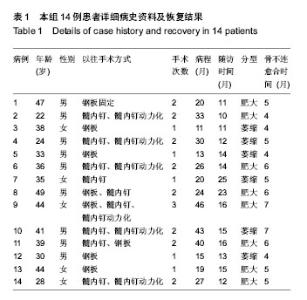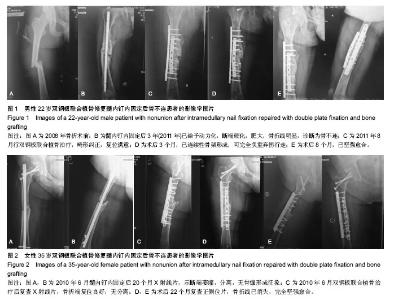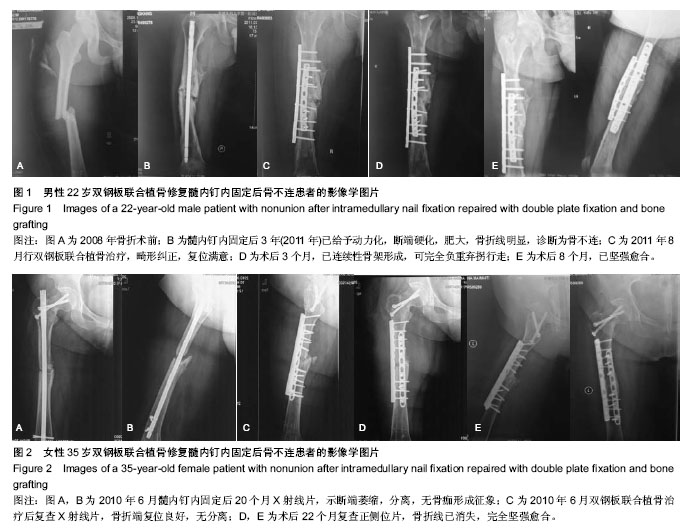| [1] McKee MD,Schemitsch EH,Yoo D,et al. A prospective study of genreal health status flollowing Ilizarov reconstrution of posttraumatic lower extremtiy defor - mity. J Bone Joint Surg Am Br. 1998;80:360-364.
[2] Tzioupis C, Giannoudis PV. Prevalence of long-bone non-unions. Injury. 2007;38(Suppl. 2):S3-9.
[3] Im GI, Shin SR.Treatment of femral shaft fractures with a titanium intramedullary nail. Clin Orthop. 2002;(401):223-229.
[4] Scott C, King JB. A prospective,double-blind trial of electrical capacitive coupling in the treatment of non-union of long bones. J Bone Joint Surg(Am). 1994;76:820-826.
[5] Hannouche D,Petite H,Sedel L. Current trends in the enhancement of fracture healing.J Bone Joint Surg(Br). 2001; 83:157-164.
[6] Beutler S, Regel G,Pape HC, et al.Extracorporeal shock wave therapy for delayed union of long bone fractures-preliminary results of a prospective cohort study. Unfallchirurg. 1999;102: 839-847.
[7] Wu CC.The effect of dynamization on slowing the healing of femur shaft fractures after interlocking nailing. J Trauma. 1997; 43:263-267.
[8] Frlke JP,Patka P.Definition and classification of fracture non-unions.Injury.2007;38 Suppl 2:S19-22.
[9] Johanson NA,Liang MH,Dahroy L,et al.Assessment instruments Reliability,validity,and sensitivity to change American Academy of Orthopaedic Surgeons lower limb outcomes.J Bone Joint Surg Am. 2004;86(5):902-909.
[10] 王亦璁.骨与关节损伤[M].北京:人民卫生出版社, 2002: 865.
[11] Canale ST. 王岩, 主译.坎贝尔骨科手术学[M].11版.北京:人民军医出版社,2009:2768-2783.
[12] Harada Y,Mistsuhashi S,Suzuki C,et al.Anatominically designed prosthesis without cement for the treatment of osteoarthritis due to developmental dysplasia of the hip:6 to 13year follow-up study. J Orthopsci. 2007;12(2):127-133.
[13] 刘桂发, 王晖.带锁髓内钉与动力加压钢板治疗股骨干骨折骨不连疗效观察[J].吉林医学, 2011,32(19):3922-3923.
[14] 顾广新, 乔晓峰, 孙梦结.下肢骨骨折后骨不愈合的原因及治疗分析[J].中国全科医学, 2007,10(20):1690-1691.
[15] 刘振东, 马梦然, 田冠宇.骨不连的界定与分类治疗[J].中国矫形外科杂志, 2007,15(20):1598-1600.
[16] 金东旭, 林森, 程相国, 等.锁定钢板内固定联合植骨治疗股骨骨不连或伴骨缺损[J].中华创伤骨科杂志, 2011,13(3):212-216.
[17] 邸军, 刘长城, 邢文钊, 等.钢板辅助固定治疗股骨干骨折髓内钉固定术后骨不连[J].实用骨科杂志, 2010,16(2):96-97.
[18] Stefano L,Nicola C,Luciano L,et al. Preliminary clinical and radio-graphic results with the fixion intramedullary nail an inflatable selflocking system for long bone fractures.J Othopaed Traumat. 2000;(3): 135-140.
[19] 宋先东, 朱敏, 张伟.胫腓骨骨折骨不愈合32例临床分析[J].牡丹江医学院学报, 2007,28(6):49-50.
[20] Sarmiento A. On the behavior of closed tibial fractures: clinical radiological correlations. J Orthop Trauma. 2000;14(3):199-205.
[21] 剂振东, 范清宇, 马保安, 等.成年狗股骨微波高温灭活后的再血管化研究[J].中华骨科杂志, 1998, 18(11):682-685.
[22] Anderson JR,Detlie T,Griffihs HJ. The radiology of bone allografts. Radiol Clin North(Am). 1995;33(2):391-400.
[23] Crowley DJ, Kanakaris NK, Giannoudis PV. Femoral diaphyseal aseptic nonunions:is there an ideal method of treatment? Injury. 2007;38(Suppl2):S55-63. |



